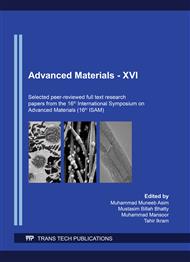p.294
p.302
p.315
p.322
p.329
p.337
p.346
p.359
p.366
Rapid Solidification and Surfaces Alloying Using Continuous CO2 Laser to Generate Ni-Aluminide on Steel
Abstract:
Rapidly solidified thin micro-alloyed surface layers are generated by laser melting of plasma thermal sprayed steel surfaces. Samples of carbon steel are plasma sprayed with fine nickel and aluminum powders. Laser surface melting generated a thin localized molten pool of metal with steep horizontal thermal gradient. The latter triggered intense vortex formation in the molten pool which thoroughly mixed the nickel and aluminum powders within the molten pool in a fraction of a second. As the sample is moved away with a predefined velocity, the cold substrate quenched the melt pool, generating rapidly solidified micro-alloyed surfaces. A 2.5 kilowatts continuous carbon dioxide laser was used for surface melting; laser power was maintained at 800 watts while the samples were moved with respect to the laser beam at linear velocities in the range of 100-200 mm/min. The technique generated metallurgical bonded novel surfaces. Depth of the laser modified layer was achieved in the range of 0.2-0.4 mm. Refined microstructures of pre-austenite grain size in the range of 4±2 µm were generated. Micro-hardness measurements of the modified layer indicate an almost three times enhancement in the hardness values; the latter are, in general indicative of mechanical strength of the material. The shape of the solid/liquid interface of the advancing molten pool determines the orientation of the growing dendrites; at higher velocities of sample translation with respect to the laser beam, these are almost parallel to the sample surface. The orientation of the dendrites, the uniformity in surface alloying (within fraction of a second) and the resulting hardness values are explained with the help of the modeled shape of the liquid metal pool. The laser processed material proved to be a flexible technique to synthesize novel surfaces for surface sensitive applications.
Info:
Periodical:
Pages:
329-336
Citation:
Online since:
February 2021
Authors:
Price:
Сopyright:
© 2021 Trans Tech Publications Ltd. All Rights Reserved
Share:
Citation:


